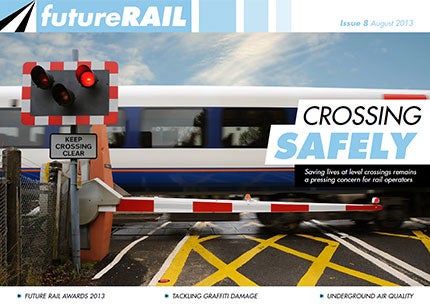
The regular occurrence of fatal accidents at level crossings proves that this age-old safety issue remains unresolved even today. We find out if modern automation technology is robust enough to provide an answer.
We also learn about the drone technology planned in Germany to take on illegal graffitists and announce the nominees for the Future Rail Innovations in Safety 2013 award.
Moreover, we find out how human behavioural science was used to transform London Bridge station into a more user-friendly commuter hub, ask whether closure is the best solution for under-used UK stations, and take a look at new research suggesting that the air quality in underground networks could be harmful to the health of regular travellers and staff.
Click here to read the latest issue.
In this issue
Crossing Safely
Level-crossing safety remains at the top of the global industry agenda as new technologies emerge. We investigate intelligent transport systems, integrated satellites and Network Rail’s £130m investment package.
Read the full article.
How well do you really know your competitors?
Access the most comprehensive Company Profiles on the market, powered by GlobalData. Save hours of research. Gain competitive edge.

Thank you!
Your download email will arrive shortly
Not ready to buy yet? Download a free sample
We are confident about the unique quality of our Company Profiles. However, we want you to make the most beneficial decision for your business, so we offer a free sample that you can download by submitting the below form
By GlobalDataFuture Rail Awards 2013
While rail may be one of the safest forms of transport, recent tragedies in Spain and Canada prove that when accidents happen they can be disastrous. Much of the work done to improve safety relies on perfecting the design and management of networks, but research into new technologies remains crucial. To celebrate innovation in this field Future Rail is launching the Innovations in Safety Award.
Read the full article.
Spy in the Sky
Deutsche Bahn is testing an unmanned drone to tackle Germany’s illegal graffitists. We ask if the system will prove effective, or if it is a step too far.
Read the full article.
Designing Behaviour
Human behavioural science is being employed at the new £700m London Bridge redevelopment to increase user-friendliness. We learns more from David Watts and Adam Parkes of CCD Design & Ergonomics.
Read the full article.
Scrap or Save
Teesside Airport Rail Station in the UK has received just 14 passengers in a year. We ask whether sixty years after the Beeching Axe, another cull could help the Department for Transport reduce expenses.
Read the full article.
Dangerous Dust
New research has shown that unregulated, ultrafine dust particles found in underground networks are rich in potentially harmful metals. We investigate the health risks for staff and passengers.
Read the full article.
Awash Woldia / Hara Gebeya Railway Line Project, Ethiopia
Awash Woldia / Hara Gebeya Railway Project is a new railway line being constructed between the Ethiopian towns of Awash and Woldia.
Read the full article.
Next issue preview
The introduction of 4G networks has been making waves in the telecommunications industry and elsewhere, but what’s in it for rail operators and passengers? We find out about the benefits, obstacles and future plans for 4G implementation on the world’s railways.
We also explore Canada’s effort to overhaul safety measures on the rail network, take a look at a futuristic virtual ticketing concept that operates from a centralised location, and find out if a new process for reforming natural gas into hydrogen could provide a fast-track to eco-friendly propulsion.
Moreover, we profile a new EU project aimed at saving energy in subway systems, and find out how a developer of energy-capturing floors is working with the Russian Railway Research Institute to explore human footfall in stations as an alternative source of energy.
Sign up for your free subscription to get each future issue delivered directly to your inbox.
Digital Magazine FAQ
The digital magazine is viewable on any computer with Flash Player installed. It is also viewable on mobile devices, iPhones and iPads, although some features and videos may be disabled.
View the archive of past issues.




